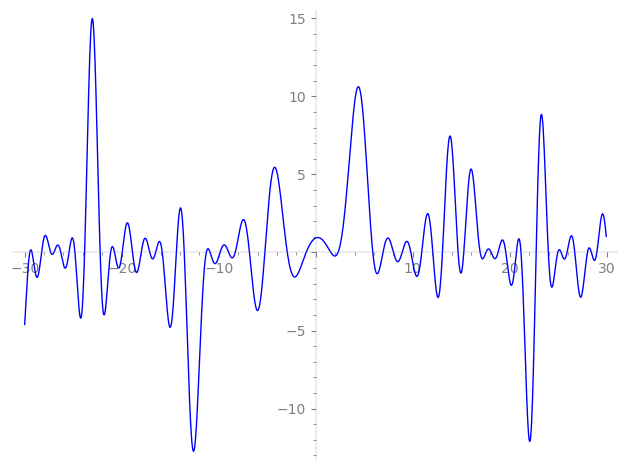| L(s) = 1 | − 5.11·2-s + (1.51 + 4.96i)3-s + 18.1·4-s + (10.9 − 2.25i)5-s + (−7.75 − 25.4i)6-s + (11.4 − 14.5i)7-s − 51.7·8-s + (−22.3 + 15.0i)9-s + (−55.9 + 11.5i)10-s − 55.4i·11-s + (27.5 + 90.0i)12-s + 20.9·13-s + (−58.6 + 74.3i)14-s + (27.8 + 51.0i)15-s + 119.·16-s − 96.8i·17-s + ⋯ |
| L(s) = 1 | − 1.80·2-s + (0.292 + 0.956i)3-s + 2.26·4-s + (0.979 − 0.201i)5-s + (−0.527 − 1.72i)6-s + (0.619 − 0.785i)7-s − 2.28·8-s + (−0.829 + 0.558i)9-s + (−1.77 + 0.364i)10-s − 1.51i·11-s + (0.661 + 2.16i)12-s + 0.447·13-s + (−1.11 + 1.41i)14-s + (0.478 + 0.877i)15-s + 1.86·16-s − 1.38i·17-s + ⋯ |
\[\begin{aligned}\Lambda(s)=\mathstrut & 105 ^{s/2} \, \Gamma_{\C}(s) \, L(s)\cr =\mathstrut & (0.985 + 0.167i)\, \overline{\Lambda}(4-s) \end{aligned}\]
\[\begin{aligned}\Lambda(s)=\mathstrut & 105 ^{s/2} \, \Gamma_{\C}(s+3/2) \, L(s)\cr =\mathstrut & (0.985 + 0.167i)\, \overline{\Lambda}(1-s) \end{aligned}\]
Particular Values
| \(L(2)\) |
\(\approx\) |
\(0.923761 - 0.0780071i\) |
| \(L(\frac12)\) |
\(\approx\) |
\(0.923761 - 0.0780071i\) |
| \(L(\frac{5}{2})\) |
|
not available |
| \(L(1)\) |
|
not available |
\(L(s) = \displaystyle \prod_{p} F_p(p^{-s})^{-1} \)
| $p$ | $F_p(T)$ |
|---|
| bad | 3 | \( 1 + (-1.51 - 4.96i)T \) |
| 5 | \( 1 + (-10.9 + 2.25i)T \) |
| 7 | \( 1 + (-11.4 + 14.5i)T \) |
| good | 2 | \( 1 + 5.11T + 8T^{2} \) |
| 11 | \( 1 + 55.4iT - 1.33e3T^{2} \) |
| 13 | \( 1 - 20.9T + 2.19e3T^{2} \) |
| 17 | \( 1 + 96.8iT - 4.91e3T^{2} \) |
| 19 | \( 1 + 33.1iT - 6.85e3T^{2} \) |
| 23 | \( 1 - 111.T + 1.21e4T^{2} \) |
| 29 | \( 1 - 156. iT - 2.43e4T^{2} \) |
| 31 | \( 1 - 80.4iT - 2.97e4T^{2} \) |
| 37 | \( 1 - 180. iT - 5.06e4T^{2} \) |
| 41 | \( 1 + 36.5T + 6.89e4T^{2} \) |
| 43 | \( 1 + 52.5iT - 7.95e4T^{2} \) |
| 47 | \( 1 - 259. iT - 1.03e5T^{2} \) |
| 53 | \( 1 + 191.T + 1.48e5T^{2} \) |
| 59 | \( 1 - 705.T + 2.05e5T^{2} \) |
| 61 | \( 1 + 427. iT - 2.26e5T^{2} \) |
| 67 | \( 1 - 306. iT - 3.00e5T^{2} \) |
| 71 | \( 1 - 513. iT - 3.57e5T^{2} \) |
| 73 | \( 1 - 360.T + 3.89e5T^{2} \) |
| 79 | \( 1 - 85.9T + 4.93e5T^{2} \) |
| 83 | \( 1 - 886. iT - 5.71e5T^{2} \) |
| 89 | \( 1 + 1.41e3T + 7.04e5T^{2} \) |
| 97 | \( 1 + 1.05e3T + 9.12e5T^{2} \) |
| show more | |
| show less | |
\(L(s) = \displaystyle\prod_p \ \prod_{j=1}^{2} (1 - \alpha_{j,p}\, p^{-s})^{-1}\)
Imaginary part of the first few zeros on the critical line
−13.55297003985906770540353384182, −11.27940831097128536108286219140, −10.88490966921897669527646173406, −9.861203184383601242869090269022, −8.971092980381759606939234116653, −8.302855800930760109382355583458, −6.83007059223266656574831939292, −5.24392469114626900241061006732, −2.92923096232705431250042482905, −0.988509975476788663802986017835,
1.56102172315707700082872309161, 2.30089475126926704108549614596, 5.88452915697134625160468438518, 6.92849954036031201729207938031, 8.012401484460106856987175761674, 8.903539726933604562971553664406, 9.809692140658259663024748521691, 10.92651560685127168887893728914, 12.07328347826713220280915821467, 13.06438397968672235788048980270

